 Reference
Reference ELB/20/35
Paper title
Fleeing Driver Policy – Recommended revision as a result of the joint IPCA/Police
thematic review
Sponsor
Deputy Commissioner Michael Clement
Presenter/s
Assistant Commissioner Sandra Venables
Prepared by
Brittany Young and Amy Weightman, National Road Policing Centre
Meeting date Monday 18 May 2020
Consultation required
Unless specifically directed by the paper’s Sponsor, papers should be presented to the SLT in the first instance, using the
SLT paper template.
1982 to Ti Lamusse
If the contents of this paper are such that they are to be presented to the ELB only, consultation may stil need to be
undertaken with other work groups / service centres / districts to ensure their views have been sought and are accurately
reflected in this paper.
For consultation purposes, please use the following group email addresses: ‘DL_Assistant Commissioners’ and
‘DL_ Consultation Group (ELB&SLT Papers)’. These email lists are frequently updated.
Please double click the boxes to tick which groups / individuals have been consulted regarding this paper and include their
feedback in the Feedback Received section.
Tick Group / individual
Specify, if required
Assistant Commissioners
Consultation Group (ELB&SLT Papers)
Police under the OIA
District staff (specify)
Workshops held in all 12 Districts
External (specify)
Police Association, Police Managers Guild, Office
of the Children’s Commissioner, Independent
Police Conduct Authority
Other (specify)
While a sponsor can exempt a paper from seeking consultation this should be an extremely rare occurrence. If your
Sponsor deems consultation to be unnecessary, a full explanation must be provided below:
by New Zealand
TRACKING: (for ES use only)
Released
 Reference
Reference
ELB/20/35
Title
Fleeing Driver Policy – Recommended policy revisions as a result of the
joint IPCA/Police thematic review
14 May 2020
Purpose
1. The purpose of this paper is to provide the Executive Leadership Board (ELB) with a revised
Fleeing Driver Policy in line with the recommendations from the joint Independent Police Conduct
Authority (IPCA) / New Zealand Police (Police) thematic review;
Fleeing Drivers in New Zealand,
A Collaborative Review of Events, Practices and Procedures.
2. Approval is sought both for the revised policy and to commence the development of training
materials to enable its successful implementation.
1982 to Ti Lamusse
Fleeing Driver Policy Background
3. In late 2016, Police and the IPCA recognised there was an opportunity to build on the collective
understanding of the fleeing driver environment. A joint thematic review was initiated, seeking to
identify and address common themes, as well as issues in existing practice where further
improvements may be required.
4. The final report “
Fleeing Drivers in New Zealand, A Collaborative Review of Events, Practices
and Procedures” was published in March 2019. This report contained eight high level
recommendations which Police agreed to action.
5. In April 2019, led by the Assistant Commissioner: Road Policing and Prevention, Police
established the Fleeing Driver Action Plan (FDAP) work programme, with a governance and
delivery structure. Separate workstreams within the FDAP group were established to manage
Police under the OIA
each of the eight recommendations (refer SLT/19/48). Pre-Covid the Fleeing Driver Steering
Group met fortnightly and has been appraised of the progress of the workstreams and discrete
pieces of work within those structures.
6. Recommendation 3 of the joint Review stipulates that:
1.
‘Police wil review the Fleeing Driver (FD) policy against the findings of the Review
and make any necessary revisions to the policy and standard operating
procedures to ensure they remain fit for purpose and support the effective
management of fleeing driver events.’
by New Zealand
7. Revisions to the FD policy have been influenced by work undertaken across all eight of the FD
work streams. A draft of the FD policy, including the proposed revisions, is attached as Appendix
C.
Rationale for Revisions to the Fleeing Driver Policy
8. The fundamental principles of the FD policy remain fit for purpose, and continue to provide
guidance
Released to our people for the effective management of fleeing driver events.
9. The purpose of the Review is to strengthen the existing policy to ensure clarity of meaning, and
ensuring the policy provides appropriate guidance, reflecting the organisation’s commitment to
ensuring the safety of the New Zealand public and our people when engaging in fleeing driver
events.
1
10. Police currently operates under a restrictive FD policy. While the existing policy does not describe
an offence threshold for initiating a pursuit, it provides guidelines on all stages of a fleeing driver
event, along with detailing available tactical options and the roles and responsibilities of those
involved.
11. In practice, the current wording of the FD policy has enabled different interpretations of the
principles. It is anticipated these varying interpretations can be mitigated through the clear use of
TENR, recognising the risks posed by FD events.
12. The objective of the work carried out under Recommendation 3 of the thematic review was to:
a. Ensure Police effectively manages the risks posed by fleeing driver events.
b. Ensure public safety is maximised and fleeing drivers are held to account.
c. Explicitly include TENR assessments at the heart of fleeing driver event management.
Specifically, the use of TENR as a tool to determine whether to signal a vehicle to stop,
commence, continue or abandon a pursuit.
d. Remove ambiguity and redundancy from the policy so that best practice operating procedures
are standardised across Districts.
1982 to Ti Lamusse
e. Provide clear direction on what constitutes poor practice and how to address it.
f. Clarify the roles and responsibilities of all staff involved in a fleeing driver event to improve the
efficiency and effectiveness of event management.
g. Incorporate into policy the broad themes of the Review and highlight the specific action points.
Development and Consultation of the Fleeing Driver Policy
13. Revisions to the FD policy were initially made by the Policy Working Group at PNHQ. The draft
policy was then reviewed by the business owner of the FD policy (National Manager: Road
Policing) to ensure the policy remained fit for purpose.
14. The draft policy was presented to the FDAP Steering Group (Steering Group) for discussion and
feedback in August 2019. The Group sought Executive approval to use the draft policy in wider
consultation with Districts. Approval was granted and the Steering Group approved release of the
Police under the OIA
draft policy for consultation with Districts and Service Centres on 7 October 2019.
15. Focus groups were established in Districts between November and December 2019. This was to
ensure operational staff were provided with an opportunity to contribute, and to test how the
policy aligned with current practice and mind sets. It also provided insight into which Districts
would require additional support to embed the proposed revisions, if approved.
16. Refinements were made to the draft policy to reflect feedback received. The draft policy was
presented to the Steering Group for final approval on 24 February 2020, before seeking wider
ELB / SLT consultation.
by New Zealand
17. There are a number of external stakeholders who are interested in Police management of FD
events, including the Police Association, the Police Managers Guild, the IPCA and Office of the
Children’s Commissioner. These external stakeholders have been kept apprised of progress
throughout the development of the revised policy, and their feedback has been considered by the
Steering Group.
18. As part o
Released f the Steering Group’s FDAP programme of work, the revised FD Policy has also had
significant input from the Steering Group throughout the eight workstreams.
Key Revisions to the Fleeing Driver Policy
19. Key revisions to the policy can be attributed to the work from the thematic review
recommendations, feedback from Districts and service centres and the outcomes of Steering
2
Group meetings. The key revisions are outlined below and a full rationale for the revisions can be
found in Appendix B.
a. The only justification for a pursuit is when the risk of harm during the pursuit is outweighed by
the threat posed by the occupants(s) of the vehicle prior to its commencement, and the
necessity to immediately apprehend the driver and/or passenger(s).
b. Consideration of the likely impact or the risk of harm by Police action or inaction.
c. Roles and management for pursuit control clarification.
d. Provision of situational intelligence by the District Command Centres (DCCs), Air Support Unit
(ASU) and any other person to inform TENR risk assessments and decision making.
e. When a pursuit has been abandoned, Police must not continue to actively search for the
offending driver unless specifically directed by the Pursuit Controller.
f. Every fleeing driver event must be resulted either K6 (reported) or K9 (arrest), with a robust
investigation undertaken to identify the driver and hold them to account. Where there is
necessity for immediate follow up, the Pursuit Controller wil direct an available supervisor to
lead these inquiries.
g. Greater emphasis on debriefs (Pursuit Controller and Field Supervisor)
1982 to Ti Lamusse
h. Greater emphasis on review process (District Reviewers)
i. Very few circumstances where a TENR risk assessment wil justify re-engagement with a
vehicle or driver involved in a previously abandoned pursuit.
Minor Changes to the Fleeing Driver Policy
20. A number of revisions have been made to make the policy easier to read:
a. The removal of superfluous and repeating sentences. For example, the repetition
of ‘Police
employees must be flexible in their response to what wil often be a rapidly changing
situation’.
b. Alphabetical reorganisation of tables for ease of access. Information split across tables and
paragraphs has now been combined into the same format.
Police under the OIA
c. Unnecessary information has been removed, such as examples of how to conduct an inquiry
and the meaning of legislation to ensure the policy is concise.
d. Definitions moved to a separate Appendix to improve readability.
e. Call sign examples standardised to aid readability.
21. The revised policy was reviewed by the Police Instructions team to ensure consistency with
existing Police policies.
22. Further to the grammatical and stylistic changes, sections of the policy were updated to include
by New Zealand
clear direction on the use of TENR. These sections now reiterate the use of TENR as a
requirement at multiple points of a fleeing driver event, beginning with the initial decision to signal
a driver to stop, commencing a pursuit, continuing a pursuit, abandoning a pursuit, and finally any
re-engagement with a fleeing driver.
Consultation on this Paper
23. This paper
Released for the ELB and the revised policy has been consulted with the Steering Group, SLT
and ELB members via the Consultation Group (ELB&SLT Papers) distribution list.
24. From this consultation round, feedback was received from the Office of the Commissioner, and
via District Commanders from Waitematā, Auckland City, Central, Bay of Plenty, Wellington and
Canterbury. Feedback is summarised in Appendix A.
3
25. In general, there is broad support for the proposed revisions to the policy.
Leadership and Governance
26. Implementation of the revised policy will require oversight to ensure that an appropriate mind-set
is embedded across Police, along with a sound understanding and application of TENR. It is
anticipated the Steering Group wil continue to oversee this work.
27. Integrating the data obtained from the FD Notification with the Use of Force database, wil provide
greater optics for Districts, Road Policing and the Executive on the implementation of the revised
policy.
28. The Steering Group wil report to the Sponsor in six months to provide an update on the
implementation and embedding of the revised policy.
Risks / Opportunities
29. The feedback received on non-compliant vehicle stops was particularly contentious. There is a
view that our people are not trained or explicitly enabled to carry out non-compliant vehicle stops,
but are regularly faced with circumstances requiring them to take affirmative action to reduce the
risk of harm.
1982 to Ti Lamusse
a. Sections 39, 40, 41 and 48 of the Crimes Act 1961 provide constables with legal authority to
use reasonable force when necessary, with Police vehicles regularly being used as a tactical
option.
b. On 27 January 2020 the Steering Group considered a Recommendations paper in relation to
the introduction of non-compliant vehicle stops in limited circumstances. The decision made
at that time was to retain the status quo, as it was considered the risks associated with
extending the use of non-compliant vehicle stops beyond AOS and STG were too significant.
c. However, this does not address or mitigate the organisational risk associated with untrained
staff using police vehicles as a tactical option in circumstances which are legally justified.
30. The policy relaunch wil require strong messaging from the Executive and consistent
reinforcement from leaders at all levels of the organisation to successful y embed the required
mind set change.
Police under the OIA
31. There is a risk that when the public becomes aware of the threshold for initiating a pursuit, those
drivers who already have little regard for road safety may become emboldened to flee, s.6(c) OIA
aland
32. There is a risk that increased awareness of the circumstances where Police is likely to abandon a
pursuit, may result in s.6(c) OIA
driving to
prompt this decision.
33. These risks can be mitigated by Police ensuring that all fleeing driver events are investigated to
identify and hold the o
by New ffending driver to account.
34. There are opportunities to use technology to enhance and support the safe management of
fleeing driver events.
a. Police has investigated the feasibility of introducing simulator training (Recommendation 2.4).
A cost benefit analysis of investing in screen simulators concluded that greater benefit wil be
Released
gained from emerging Virtual Reality (VR) technology. VR technology currently available is
not fit for purpose, however The Royal New Zealand Police College (RNZPC) has
commenced development of test products to advance this option for Police across the entire
suite of tactical decision-making set ings. It is expected there wil be significant progress
made in the next 12 months.
4
b. Recommendation 7.3 of the Review requires Police to ‘Investigate the use of location
technology for National Communications incident resource deployment and management
during events’. Location technology is currently used in the Deployment and Safety (DAS)
application which provides location details of officers. The Situational Awareness Mapping
(SAM) application complements DAS by providing location information of surrounding officers.
Data for both applications originates from mobility devices.
c. The Police Fleet Group recently commenced the deployment of ‘telematics’, which is a
method of monitoring a vehicle by combining a GPS system with on-board diagnostics. At
this stage, telematics is only being used to automate the uploading of odometer information.
There is an opportunity to extend the use of telematics to capture near real time data
(including location, direction and speed), which originates from the vehicle. This technology is
widely used in the private sector and other government agencies, with proven benefits in
relation to improving employee driver behaviour.
d. Investigations are currently leading a project in conjunction with NZTA to digitise the process
for sharing CCTV footage with Police. Once completed, this wil enhance the ability of our
people to easily obtain footage as part of any subsequent investigation into fleeing driver
events.
1982 to Ti Lamusse
35. Fleeing drivers are a matter of considerable public interest. Any shift in Police policy is likely to
draw attention from the press and public, and could impact on trust and confidence. Given the
mixed public opinion, and the contentious nature of the issue, it is recommended a
communications plan be developed to ensure careful consideration of risk management.
Financial Implications
36. There are no specific financial implications associated with the implementation of the revised
policy.
37. A training and implementation package wil be required to ensure that our people understand and
can apply the revised Fleeing Driver policy appropriately. It is anticipated this wil be funded from
within baseline.
Resourcing / Staff Implications
Police under the OIA
38. There are no anticipated resourcing concerns or people implications.
39. There may be potential extractions as a result of training. The training plan is yet to be developed;
some rostering changes may be required.
IT Implications
40. There are no anticipated IT implications with implementing the revised policy.
Māori, Pacific and Ethnic Peoples
41. The revised FD Policy does not have any specific implications for Māori, Pacific and Ethnic
by New Zealand
Peoples.
42 Given the over-representation of Māori, Pacific and Ethnic Peoples (particularly youth drivers) in
FD events, any changes that improve safety outcomes may have an impact on reducing the
disproportionately negative outcomes for Māori.
Alignment w
Released
ith Strategic Priorities
43. Improved management of fleeing driver events has potential impacts for improved strategic
outcomes in alignment with a number of our targets.
44. Any commitment to improved road safety outcomes wil have a positive impact on Police’s
commitment to reducing road deaths by 5%. Revisions to the FD policy have been specifically
5
made to support improved decision making and professional driving practices, along with
minimising the risks to road users when a driver chooses to flee.
45. Increased emphasis on identifying and holding fleeing drivers to account through robust
investigation processes ensures that high risk drivers are dealt with in a manner that reduces the
risk to other road users and enhances public trust and confidence.
46. Appropriate application of TENR, in addition to more robust investigative processes, may result in
a reduction in recidivist fleeing driver behaviour and positively impact on a 25% reduction in Māori
reoffending.
Legislative Implications
47. There are no anticipated legislative implications.
Health and Safety Implications
48. By increasing the emphasis on TENR to justify a pursuit, it is anticipated there wil be a reduction
in risk as our people engage in fewer pursuits.
Training and Implementation Implications
1982 to Ti Lamusse
49. Internal communications and ongoing training wil be required to embed the required mind set
shift.
50. Messaging needs to be endorsed and delivered by a senior Executive member to ensure our
people understand the significance of the revisions that have been made to the FD policy and
organisational expectations.
51. A training and implementation package wil need to be developed and delivered to ensure our
people understand and can apply the revised FD policy appropriately.
District Implications
52. District Leadership Teams (DLTs) wil be crucial to leading the required change in mind set.
District champions wil be identified to support DLTs and deliver face-to-face training.
Police under the OIA
Implications for other Agencies
53. There are no specific implications for other agencies relating to the revisions of the Fleeing Driver
policy. However, it is important to note that any revisions made to this policy will incur great
interest from other agencies; eg, Office of the Children’s Commissioner and the Independent
Policy Conduct Authority.
Communications
54. An appropriate media strategy wil need to be determined between the Media and
Communications Team, and the FDAP Steering Group once the revised policy has been
approved.
by New Zealand
Released
6
 Recommendations
Recommendations
55. It is recommended the Executive Leadership Board:
(i)
Note that there may be further revisions to the Fleeing Driver policy required, following the
completion of work from other Fleeing Driver Action Plan recommendations;
(ii)
Approve:
(a) The proposed revisions to the Fleeing Driver policy;
(b) The development of an e-learning package for frontline staff to support the launch of
the revised policy.
(iii)
Endorse that a communications plan be developed to accompany changes to the Policy;
(iv)
Direct that a communications plan be developed to accompany changes to the Policy.
1982 to Ti Lamusse
_________________________________
Michael Clement
Deputy Commissioner: National Operations
Police under the OIA
by New Zealand
Released
7

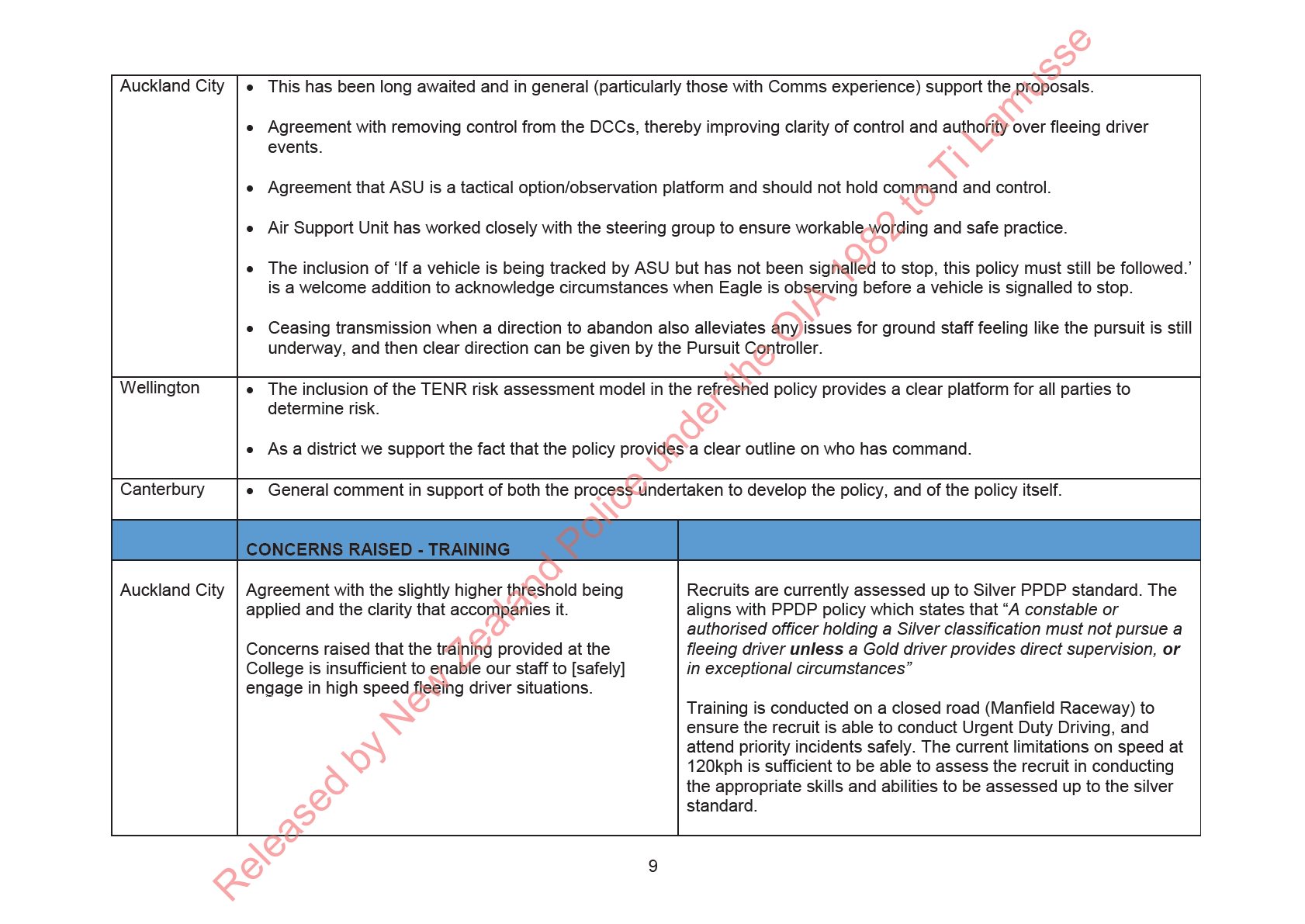
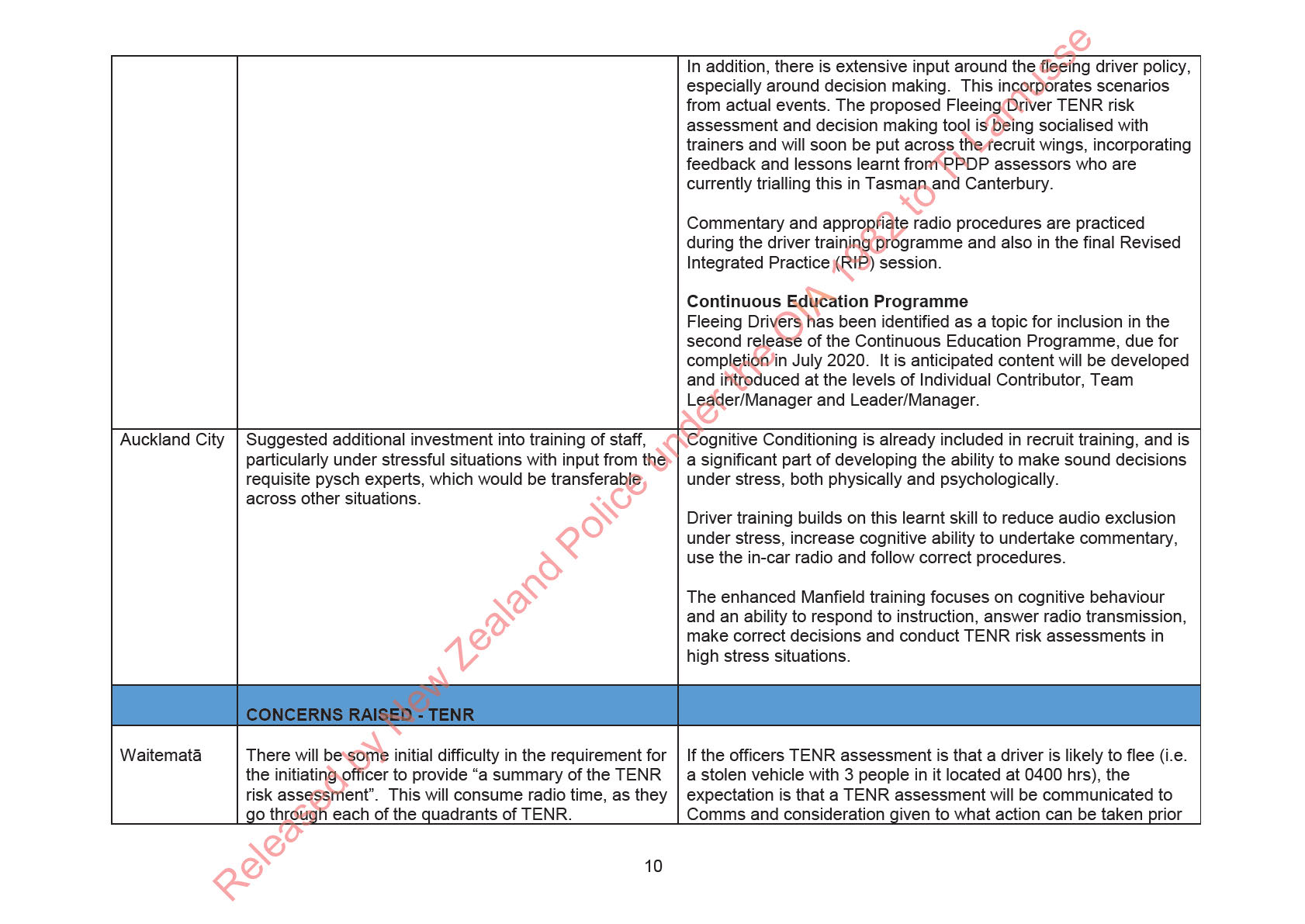

pursuit, and directs abandonment, the worst criticism Police wil
face is that we failed to adhere to this aspect of the policy, but
instead took a more risk adverse approach.
This action can be justified by one of the overarching principles,
being that;
• Al staff share a collective responsibility to achieve the common
purpose of ensuring the fleeing driver event is managed as
safely as possible
After consultation with Districts and Police Communicat
1982 to Ti Lamusse ions, the
decision made by the Steering Group was that Dispatchers should
be given authority to abandon when;
a) TENR is not provided i.e. the reason for the pursuit is not
provided, or
b) TENR provided is insufficient to justify a pursuit i.e. a minor
traffic violation does not justify a pursuit
Many Shift Commanders already provide Dispatchers with
delegated authority to abandon, so this adjustment is affirming
current practice, as well as giving effect to the recommendation
from the Police / IPCA review.
The wording of the policy is that ‘Dispatchers
may abandon…. ’
This provides an elem
Police under the OIA ent of protection for dispatchers in terms of
where responsibility rests in the event that the outcomes are less
than ideal, and emphasises that ultimately control and command
rests with the Pursuit Controller.
Wellington
The district feedback focuses on leadership and
It has been recognised that Comms staff, particularly new
command and control as holding the most significant
dispatchers, wil require additional training around fleeing driver
weight. As with any critical incident management
events. A Comms training framework is being developed to
leadership, command and control is pivotal.
address this need.
by New Zealand
We wonder whether Comms have the skil set to
command these events. As a district we are acutely
aware that the Central Communication Centre often
12
Released
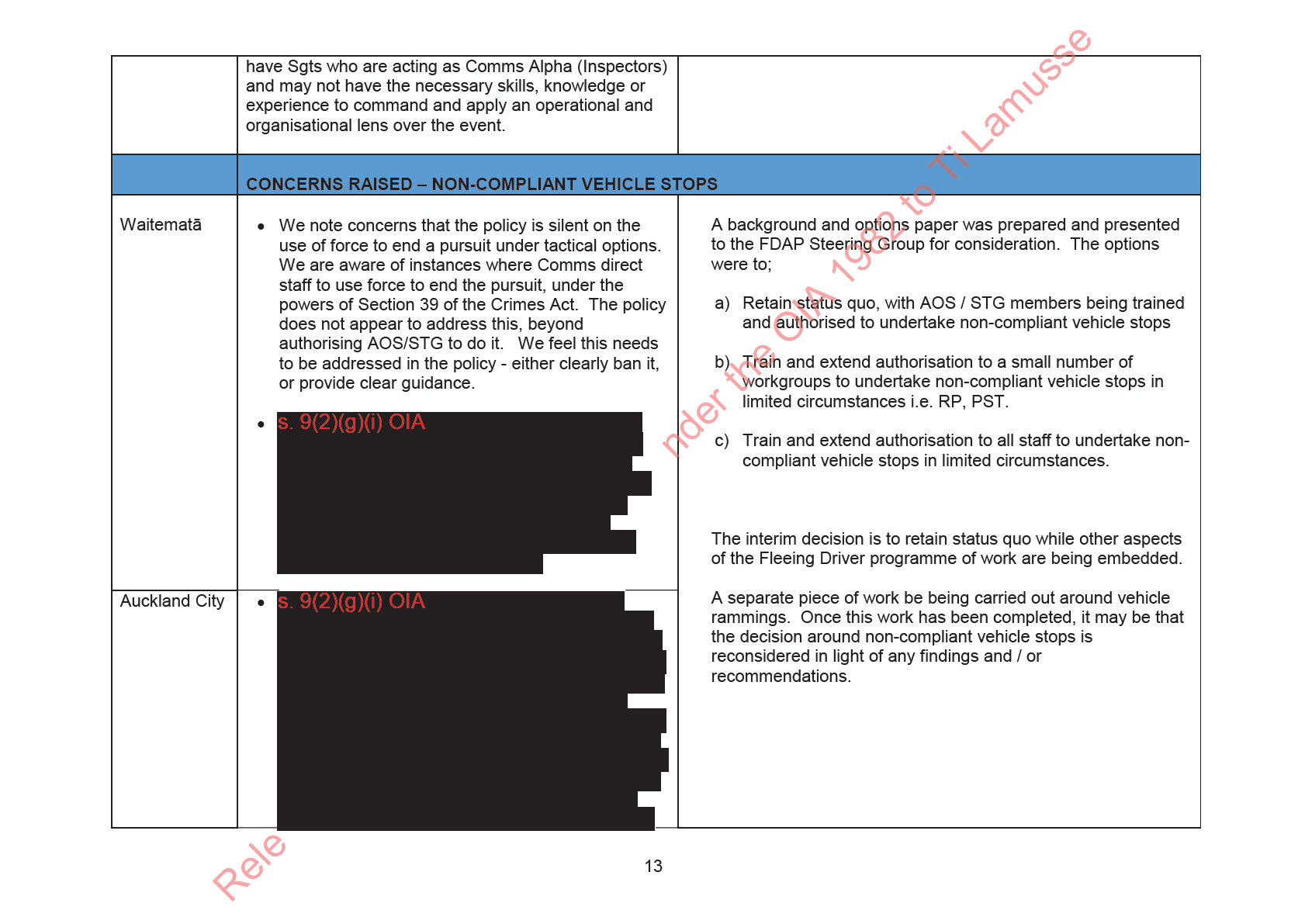

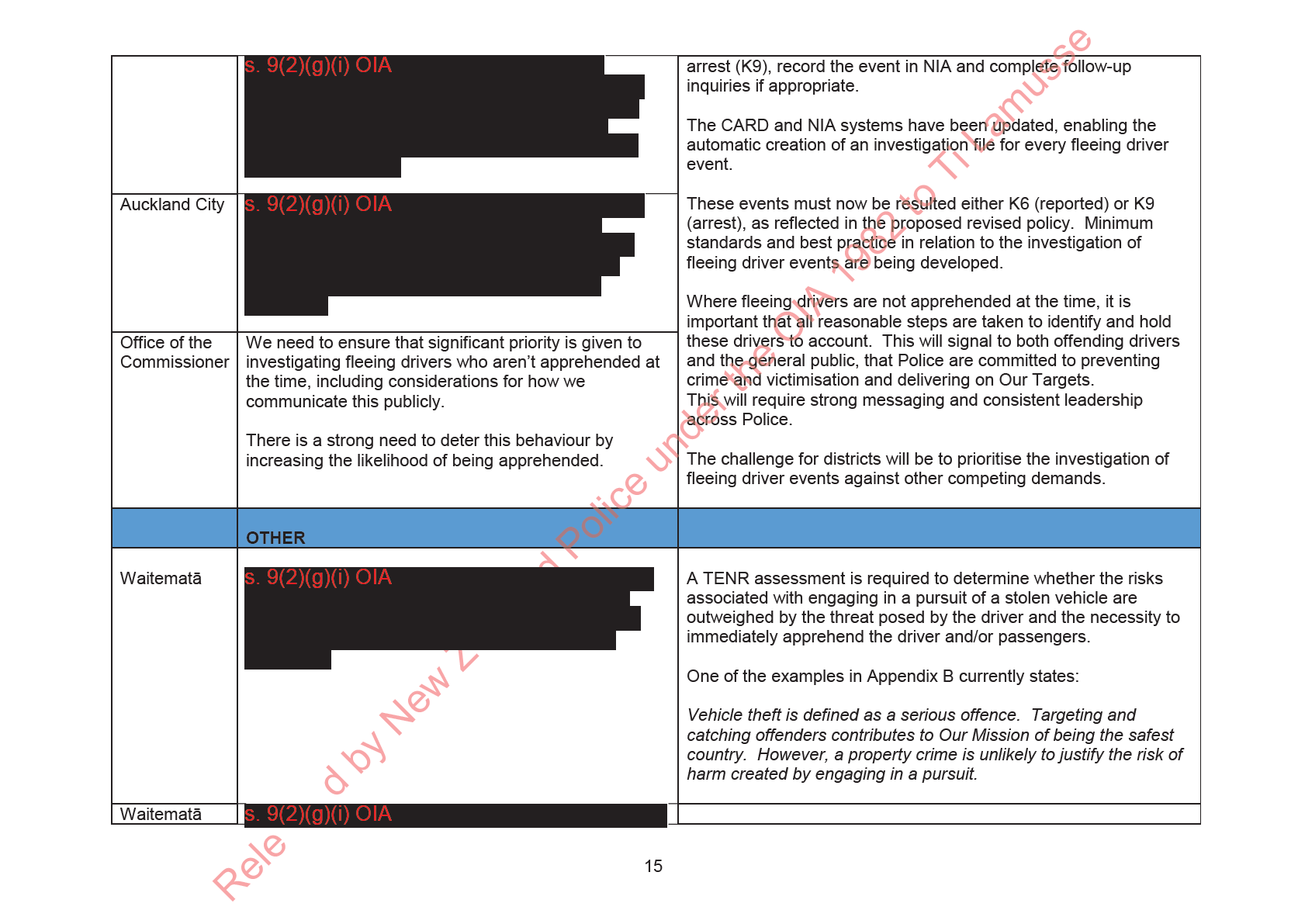
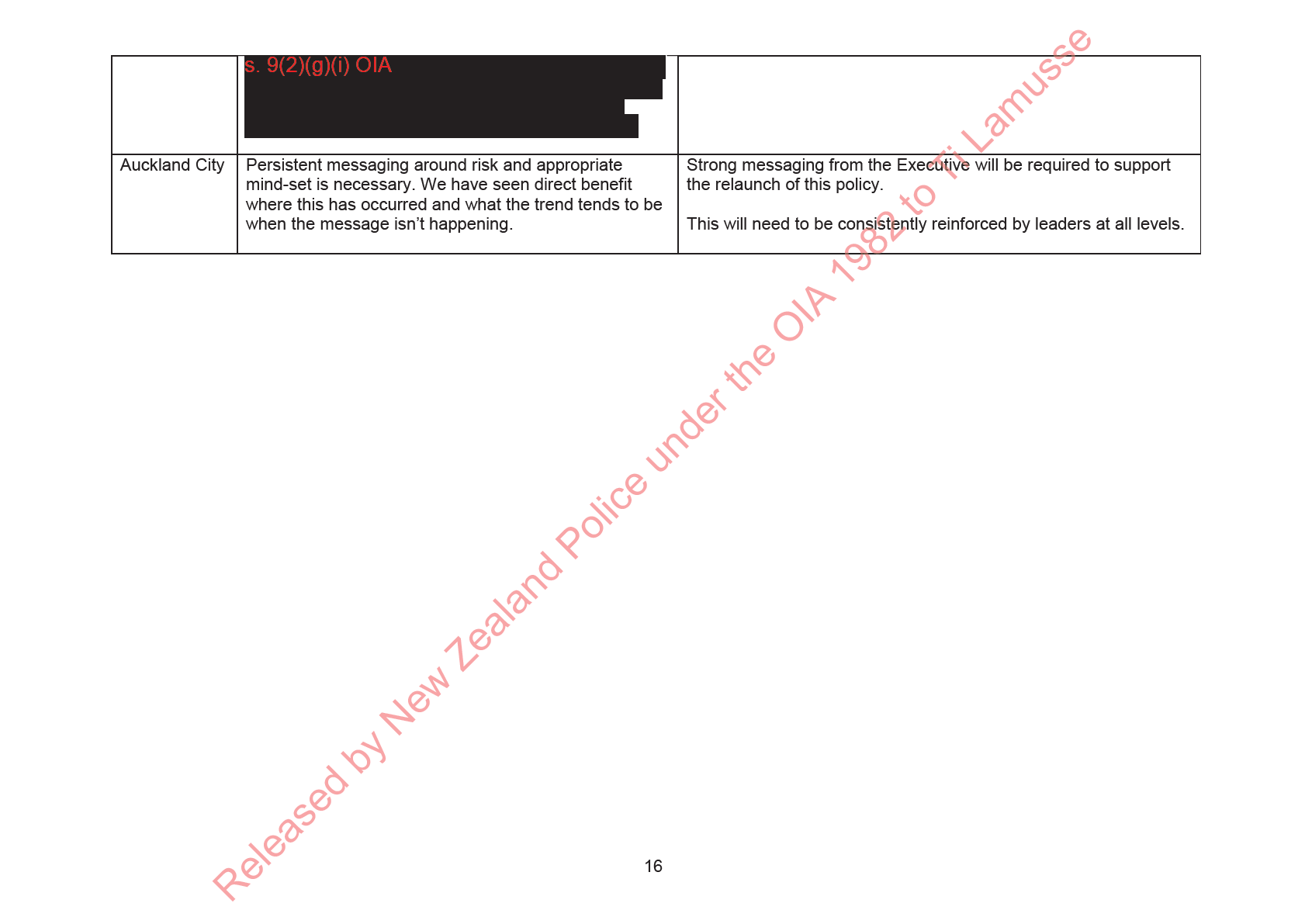

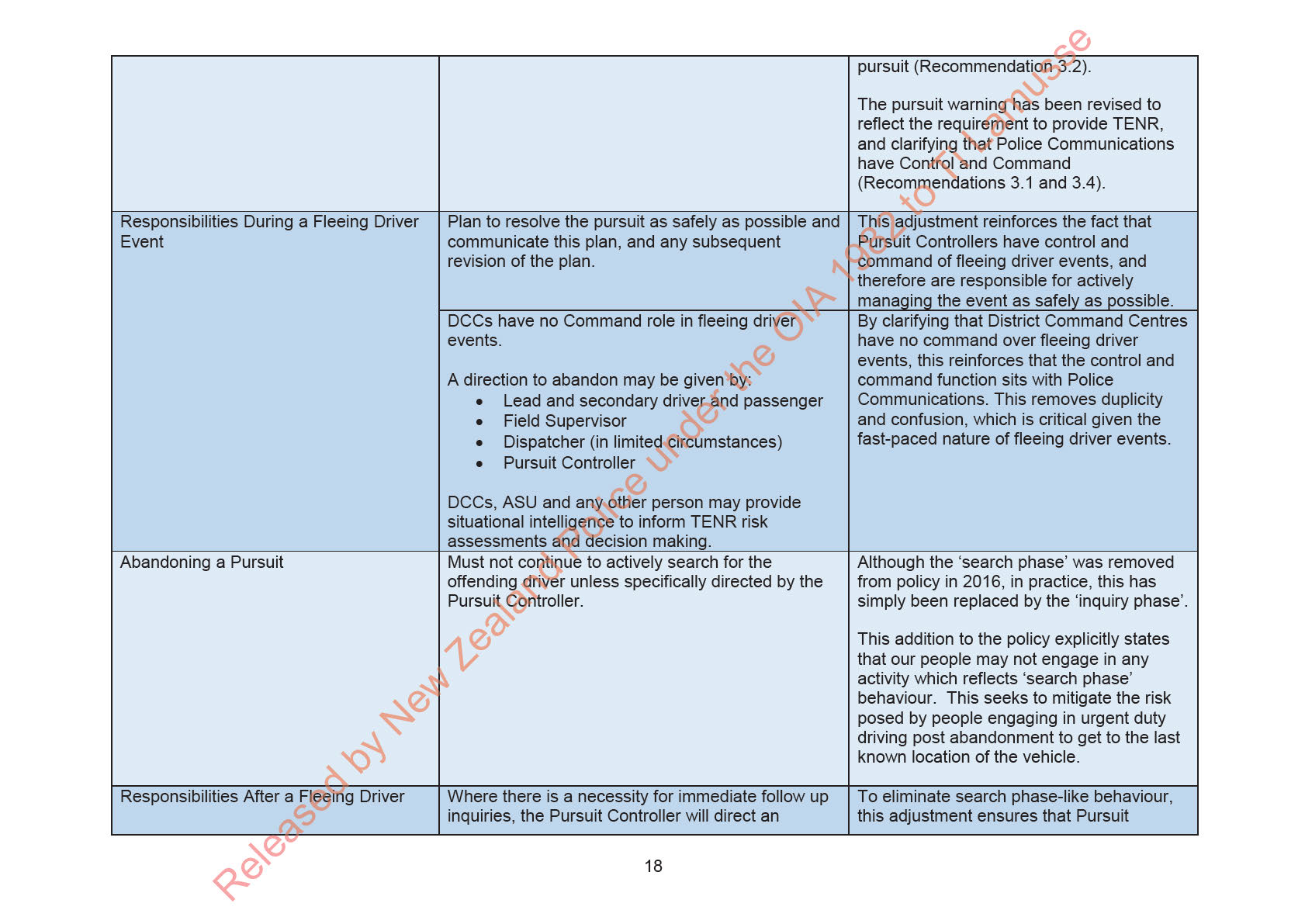
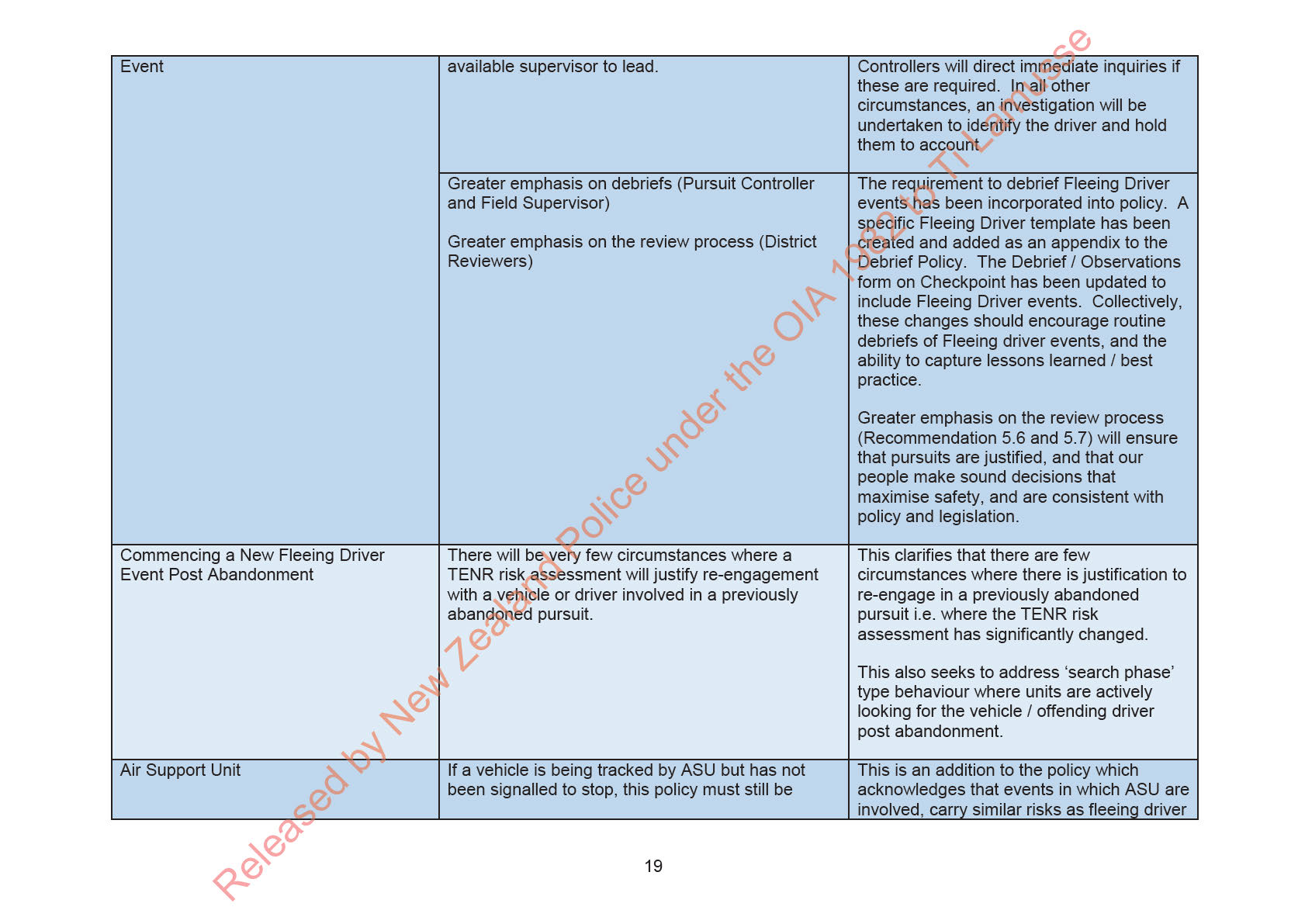
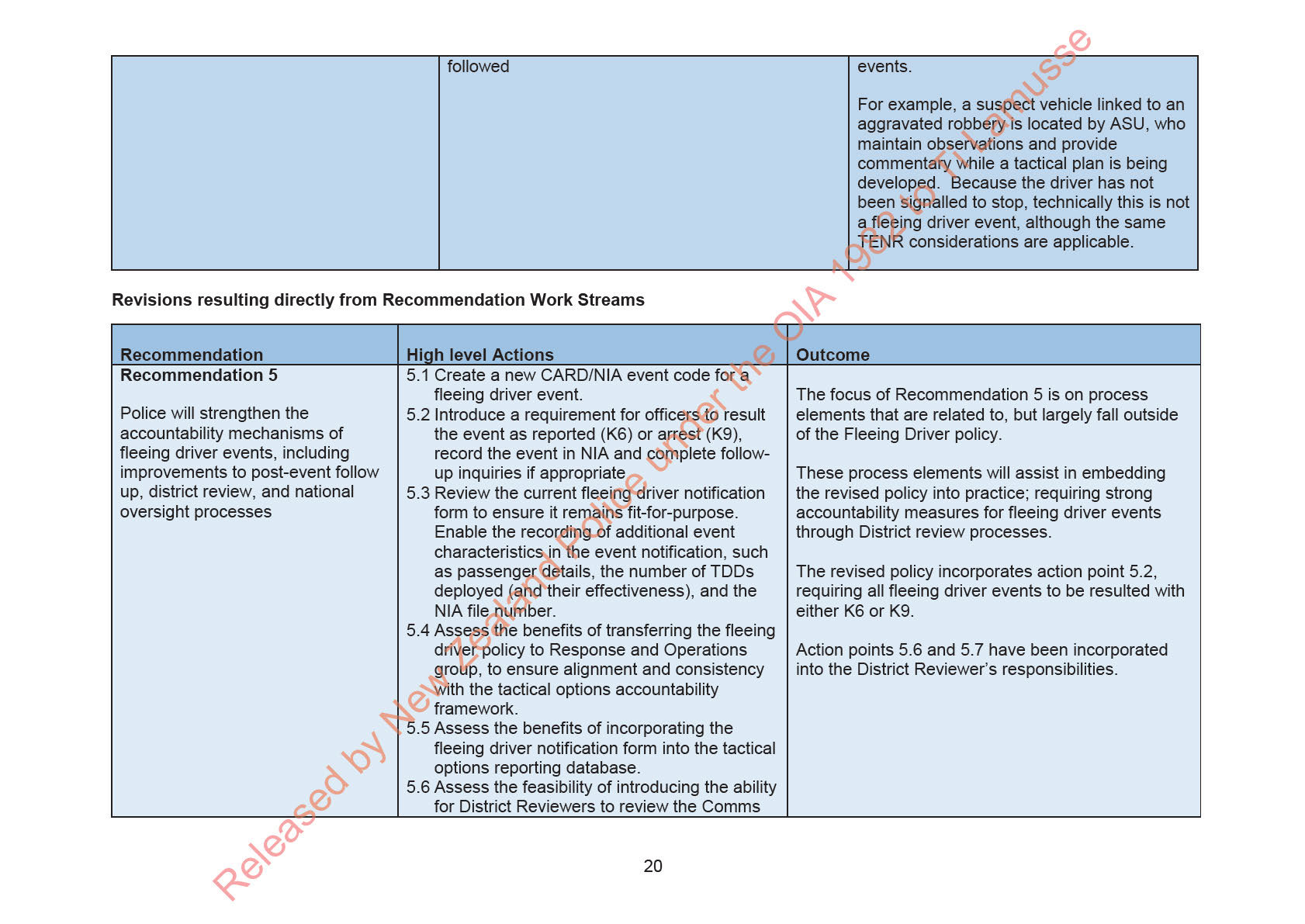

Appendix C – Draft Fleeing Driver Policy.
Policy standards and principles
What
The decision to stop a driver is one of the most dangerous activities that Police undertake on a
daily basis, and may be the beginning of a fleeing driver event.
A fleeing driver is a driver who has been signalled to stop by a constable but refuses to stop or
remain stopped.
This can create a high risk, fast paced event which evolves rapidly, exposing all road users,
including the fleeing driver and any passengers to significant risk.
Why
The purpose of this policy is to guide staff decision making around signall ng a driver to stop,
and in the event of a fleeing driver, how to achieve the safest possible outcomes for the public,
vehicle occupants and Police staff.
1982 to Ti Lamusse
Safety is the paramount consideration when initiating and resolving any fleeing driver event.
This will be achieved through the use of ongoing TENR risk assessments and a clear and
common understanding and application of roles and responsibilities.
How
The decision to signal a driver to stop, to commence, continue or abandon a fleeing driver
event must be justified by a continuous TENR risk assessment.
The overriding principle when applying TENR is that ‘safety is success’. Every effort must be
made to minimize harm and maximize safety.
The TENR risk assessment must balance the initial threat posed by the vehicle occupant(s);
Police under the OIA
the necessity to immediately apprehend the driver and/or passenger(s); and the risk of harm
to any person during a pursuit
Each pursuit will be reviewed to determine whether it was:
• appropriate,
• lawful,
• justified, taking into account all of the circumstances in front of them
• compliant with Police Instructions, and
• whether there are lessons to be learnt and applied.
by New Zealand
Overall principles
• An investigation is preferred over the commencement or continuation of a pursuit.
• Safety of the public, vehicle occupant(s) and staff takes precedence over the immediate
apprehension of a fleeing driver.
Released
• A pursuit is only justified when the risk of harm during the pursuit is outweighed by the
threat posed by the occupants(s) of the vehicle prior to the pursuit commencing, and the
necessity to immediately apprehend the driver and/or passenger(s).
• Police will consider the likely impact of Police action or inaction on the risk of harm,
particularly where children or young people are involved.
22
• All staff share a collective responsibility to achieve the common purpose of ensuring the
fleeing driver event is managed as safely as possible.
• Sound decision making, demonstrating appropriate application of TENR regarding the
initiation, continuation or abandonment of a fleeing driver event will be supported.
• All fleeing driver events will be investigated to identify the offender and hold them to
account.
• Fleeing driver events will be reviewed in a timely manner to identify and effectively manage
or escalate any health and safety risks, training issues, systemic issues or lessons learnt.
• Staff may be criminally liable if their manner of driving contravenes legislation.
Related legislation and policy
The following legislation may be applicable to fleeing driver events:
• Crimes Act 1961
1982 to Ti Lamusse
• Health and Safety at Work Act 2015
• Land Transport Act 1998
• Land Transport (Road User) Rule 2004
• Policing Act 2008
• Search and Surveillance Act 2012
Related policies include:
• Critical Incident Policy
• Debrief Policy
• Digital Media Policy
• Perimeter Control
• Police Vehicle Management (PVM)
• Professional Police Driver Programme (PPDP)
• Radio and Communication Centre Protocols
• Traffic Patrol Techniques
Police under the OIA
• Tyre deflation devices (TDD)
• Urgent Duty Driving (UDD)
• Use of Force
• TENR-Operational threat assessment
Decision to stop a driver
Vehicle stops are unpredictable and signaling a driver to stop may initiate a fleeing driver
event.
Because of the inherent risks, a TENR risk assessment must be completed before signaling the
by New Zealand
driver to stop.
The TENR risk assessment must balance the initial threat posed by the vehicle occupant(s);
the necessity to immediately apprehend the driver and/or passenger(s); and the risk of harm
to any person created by commencing a pursuit.
Consideration should always be given to delaying the signal to stop while coordinating tactical
Released
options, and/or waiting for the wider environment to become safer and the risk reduced.
Having made a decision to signal the driver to stop, the initiating officer will also make a
decision (prior to activating lights and sirens) about whether or not to commence a pursuit if
the driver fails to stop or remain stopped.
23
If the TENR risk assessment leads to the conclusion that a fleeing driver event is likely, and the
decision is made to signal the driver to stop, Police Communications must be advised of:
- A summary of the TENR risk assessment
- The tactical options considered (including ASU where available), and
- The intention to signal the driver to stop
- Whether or not a pursuit is going to be initiated if the driver fails to stop
TENR
Considerations include but are not limited to:
What is the threat
• Reason for stopping, e.g. vehicle and licence check, breath
posed by the driver
testing, traffic or criminal offence
and/or vehicle
• The broader threat posed by the driver
occupants?
• The safety of other road users and yourself
• Identity of the driver and/or passengers
What are the risks if
• Likely age of driver, the impact of age on their decision making
the driver is not
ability and driving experience
stopped?
• Number and likely age of passengers and their influence on the
driver
What impact is your
• Manner and speed of driving
action or inaction
• Environmental circumstances (e.g. road conditions, traffic
likely to have on the
density, foot traffic, school hours/proximity, weather, driver
1982 to Ti Lamusse
risk of harm?
behavior and condition of vehicle
• Likelihood of the driver failing to stop when signaled to do so e.g.
What alternative
driver of a stolen vehicle
options are there for
resolving the event
safely?
Driver fails to stop after signal ing
Regardless of the reason, all drivers who fail to stop when signaled to do so will be managed in
accordance with this policy.
This includes drivers who;
Police under the OIA
• Are unaware of the signal to stop,
• Are unaware of the required action when signaled to stop by Police, or
• Consciously and deliberately fails to stop or remain stopped.
The threat, exposure, necessity and associated risks are different in each of these
circumstances, and will inform an appropriate response and resolution.
The fact that a driver fails to stop or remain stopped for Police, is not in itself, sufficient reason
to commence a pursuit.
If the driver fails to stop when signaled to do so, Police will make a decision whether to;
a) not engage in a pursuit and seek to resolve the matter through alternative action, or
by New Zealand
b) commence a pursuit
Decision to pursue
If the decision is made to commence a pursuit, a summary of the threat, exposure and
necessity must be communicated to Police Communications.
Released
Appendix B provides examples of the type of communication expected.
24
Radio protocol
Step Action
1
Police driver/passenger must advise the Dispatcher of the pursuit, as soon as
practicable, including their justification for the pursuit if not already provided.
“Comms, {Call sign}, in pursuit. [Direction] on [road]. Previous TENR
applies.”
Alternatively;
“Comms, {Call sign}, in pursuit. [Direction] on [road].”
Dispatcher acknowledges.
“{Call sign}, go ahead”
The unit must provide a summary of the threat, exposure and necessity to pursue
based on a TENR risk assessment.
1982 to Ti Lamusse
The Dispatcher may abandon the pursuit where a summary of the TENR risk
assessment has not been provided or is insufficient to justify a pursuit.
2a
If the Dispatcher is satisfied that a summary of TENR has been adequately
communicated, they acknowledge by issuing the pursuit warning.
“{Call sign} TENR acknowledged. Comms has command. Safety is your
priority.”
Responsibilities during a fleeing driver event
All staff share a collective responsibility to achieve the common purpose of resolving the
fleeing driver event as safely as possible.
Police under the OIA
The table below defines roles and responsibilities during a fleeing driver event.
Lead vehicle • Ensure warning lights and sirens are activated.
driver
• Notify Police Communications as soon as practicable that a pursuit has
been entered into including the TENR assessment justifying the pursuit
and/or
location, direction, vehicle description.
• Acknowledge the pursuit warning from Police Communications.
Police
• Continuously perform a TENR assessment to assess whether the risks
constable
associated with the pursuit are justified.
passenger
• Ensure all information relevant to risk is communicated to Police
by New Zealand
Communications.
• Comply with all directions from the Dispatcher or Pursuit Controller.
• Abandon the pursuit if their TENR risk assessment supports this
response.
Note: notwithstanding the above, no driver can be directed to commence
Released
or continue a fleeing driver pursuit against their judgement.
Dispatcher
• Acknowledge notification of the TENR risk assessment and pursuit by
providing the pursuit warning.
• May abandon the pursuit where a summary of the TENR risk assessment
has not been provided or is insufficient to justify a pursuit.
• Conveys the TENR risk assessment justifying the decision to pursue to
the Pursuit Controller.
25
• Maintains essential radio communications with all units.
• Complies with all directions from the Pursuit Controller.
• If no Pursuit Controller or Team Leader is available, must direct the
abandonment of a pursuit.
Secondary
• Continuously perform a TENR assessment to assess whether the risks
vehicle
associated with the pursuit are justified.
driver
• Ensure warning lights and sirens are activated.
• Notify Police Communications as soon as practicable they are the
and /or
secondary vehicle.
• Acknowledge the pursuit warning from Police Communications.
Police
• Follow behind the lead vehicle at a safe distance to provide support and
constable
tactical options.
passenger
• Take over the pursuit commentary if the lead vehicle is single crewed.
• Comply with all directions from the Dispatcher or Pursuit Controller.
• Direct the abandonment of the pursuit if their TENR risk assessment
supports this response.
Pursuit
• Is responsible for overall command and control of the fleeing driver
Controller
event.
• Ensures an adequate TENR risk assessment has been provided.
1982 to Ti Lamusse
• Ensures the pursuit warning has been given and acknowledged by the
lead vehicle, and secondary vehicle if present
• Continuously performs own TENR assessment to assess whether the risks
associated with the pursuit are justified.
• Plan to resolve the pursuit as safely as possible and communicate this
plan, and any subsequent revision of the plan.
• Direct the abandonment of the pursuit where:
- Their TENR risk assessment supports this response
The identity of the fleeing driver becomes known and/or the fleeing
driver does not pose an immediate threat and it is likely they can be
safely apprehended later.
- Pursing unit(s) have lost contact with the fleeing driver.
- Sustained loss of communication with pursuing unit(s).
• If available resources allow:
- Ensure a secondary vehicle takes over the pursuit commentary if the
Police under the OIA
lead vehicle is single-crewed
- Replace unmarked vehicles (category B) with marked vehicles
(category A) at the earliest opportunity
- Replace a single crewed lead vehicle with a two person unit as soon as
practicable.
• Limit the number of Police units following the fleeing driver to no more
than two, unless tactically appropriate.
• Coordinate tactical units and options to safely resolve the event
(including the Air Support Unit where available).
• Monitor situation reports to ensure sufficient and relevant information is
provided to enable informed decision making.
by New Zealand
• Broadcast the reason for abandonment to all units if the pursuit is
abandoned.
Field
• Maintains supervisory oversight.
Supervisor
• Provides support to staff and the Pursuit Controller, avoiding direct
involvement in the pursuit where possible.
• Continuously performs own TENR assessment to assess whether the risks
associated with the pursuit are justified.
Released
• Directs abandonment of the pursuit if their TENR risk assessment
supports this response.
Other units
• Must cease all non-essential radio communication.
responding
• Must not follow behind the fleeing driver pursuit unless directed or
as a tactical
approved to do so by the Pursuit Controller.
option,
• Notify the Pursuit Controller of location and tactical options available.
26
including
• Ensure their tactical response assists with the safe management of the
ASU
fleeing driver event.
• Continuously perform a TENR risk assessment to assess whether the
risks associated with the pursuit are justified.
• Comply with all directions from the Dispatcher or Pursuit Controller.
All other
• Must cease all non-essential radio communication.
units
District
• Have no Command role in fleeing driver events.
Command
• May provides situational intelligence to staff and the Pursuit Controller.
Centre (DCC)
and NCCC
Communication and TENR during a fleeing driver event
Communication
Staff responsible for providing communication during the fleeing driver event must provide
timely and relevant sit-reps to Police Communications.
1982 to Ti Lamusse
The priority is to convey the highest relevant risk information early to inform the Pursuit
Controller’s TENR risk assessment, enabling effective command of the fleeing driver event.
TENR risk assessment during a fleeing driver event
Continuous TENR risk assessments must be carried out by all staff involved in a fleeing driver
event, including other Police units responding as a requested tactical option, until the pursuit is
resolved or abandoned.
This includes identification and communication of risks to inform TENR risk assessments and
decision making.
TENR
Considerations include but are not limited to:
Police under the OIA
What is the threat
• Frequency and sufficiency of sit-reps (continuing TENR).
posed by the
• Whether a fleeing driver was driving normally prior to being
driver?
signaled to stop, but is now driving in a dangerous or reckless
manner due to Police presence.
What are the risks
• Changed circumstances e.g. road conditions, traffic density, foot
if the driver/vehicle
traffic, school hours/proximity, weather, driver behavior, and
is not stopped?
condition of vehicle.
• Nature and seriousness of offence(s) committed or about to be
Who may be
committed.
exposed to harm as • Identity of the driver and/or passengers.
a result of a
• Likely age of driver, the impact of age on their decision making
pursuit?
ability and d
by New Zealand riving experience
• Number and age of passengers and their likely influence on the
What impact is
driver.
your action /
• Safety of all road users, including Police.
inaction likely to
• Manner and speed of driving.
have on the risk of • The broader threat posed by the driver.
harm?
• Vehicle type i.e. motorcycle, heavy vehicle
Released
• Could the event be resolved by alternative means such as an
What alternative
investigation?
options are there
• Is continuing the pursuit worth the risk of causing death or serious
for resolving the
injury to any person?
event safely?
27
Abandoning a pursuit
Decisions to abandon a pursuit will be supported.
When a TENR risk assessment supports abandonment of the pursuit, the following procedure
and radio communication protocols must be followed.
Radio protocol
Dispatcher Must abandon the pursuit where a summary of the TENR risk assessment
has not been provided or is insufficient to justify a pursuit.
“All units from Comms. Abandon pursuit now – {reason for
abandonment}.”
Lead and
secondary
Must abandon a pursuit if their TENR assessment supports this response.
vehicle
driver and /
“All units from {call sign}. Abandon pursuit now – {reason for
1982 to Ti Lamusse
or Police
abandonment}”
constable
passenger
Field
Supervisor
Pursuit
Must abandon a pursuit if:
Controller
• Their TENR risk assessment supports this response.
• The identity of the fleeing driver becomes known and/or the fleeing
driver does not pose an immediate threat, and it is likely they can be
safely apprehended later.
• Contact has been lost with the fleeing driver.
“All units from Comms Alpha. Abandon pursuit now - {reason for
abandonment}.” Police under the OIA
Action when directed to abandon pursuit
Following a direction to abandon a pursuit, all units must carry out the following:
Ground Units
1. Acknowledge the direction to abandon the pursuit.
2. Immediately reduce speed to inc
by New Zealand rease the distance between the fleeing driver and their
own vehicle.
3. Deactivate warning devices once below the posted speed limit.
4. Stop as soon as it is safe to do so. If stopping in an area such as a motorway, safety may
necessitate that warning lights remain activated until the vehicle is mobile again.
5. Advise the Pursuit Controller they are stationary and state their specific location:
“Comms {Call sign}. Stationary at {location e.g. 123 Henry St}.”
Released
6. Must not continue to actively search for the offending driver post abandonment, unless
specifically directed by the Pursuit Controller.
7. Resume normal duties or deploy to other events as directed by Police Communications.
28
Air Support Unit
ASU will immediately cease all radio transmissions and await further direction from the Pursuit
Controller.
Refer to the ASU section of this policy for further details.
Responsibilities after a fleeing driver event
This table outlines responsibilities after a fleeing driver event.
Dispatcher • Ensure a CARD event has been entered for the fleeing driver event and is
resulted with either a K6 or K9 as appropriate.
Pursuit
• Ensure the ‘Comms’ section of the Fleeing Driver Notification form is
Controller
completed as soon as practicable after the fleeing driver event, but no
later than the
end of shift.*
• Debrief with Comms and District staff to identify areas for improvement
and reinforce best practice.
Lead Vehicle • Advise Comms to result the fleeing driver event either K6 or K9.
1982 to Ti Lamusse
Driver and / • Ensure the ‘Pursuit Details’ section of the Fleeing Driver Notification form
or Constable
is completed by the
end of shift.*
Passenger
• Ensure that a NIA file is created and updated by
the end of shift.*
• Where a Health and Safety Incident or near miss has occurred, a
MyPolice incident or near miss must be recorded by
the end of shift.*
Field
• Debrief with Comms and District staff to identify areas for improvement
Supervisor
and reinforce best practice.
• Ensure the Fleeing Driver Notification form and NIA records are updated
before the
end of shift*.
• If any staff member is unable to complete the form, or they have been
involved in a pursuit resulting in the serious injury or death, the
supervisor should complete and approve on their behalf.
• Review and approve the Fleeing Driver Notification form within
5 days*.
• Ensure required Health and Safety reporting has been completed.
Police under the OIA
• Ensure an investigation is completed to identify the offender and hold
them to account.
TDD
• Ensure the ‘TDD Details’ section of the Fleeing Driver Notification form is
deploying
completed by the
end of the shift*.
officer
District
• Review the Fleeing Driver Notification forms to ensure compliance with
Reviewer
this chapter,
within 5 days* of the review request.
• Review the Police Communications audio recording
• Review any ASU footage in conjunction with an ASU representative in
compliance with the Digital Media Policy.
• Identify and effectively manage or escalate any health and safety risks,
training issues, s
by New Zealand ystemic issues or lessons learnt.
• Ensure all fleeing driver events have a corresponding NIA record.
• Comply with any national review process.
* Where reporting timeframes cannot be met due to exceptional circumstances, ensure all
known information is populated within the required timeframes, and the form completed as
soon as possible.
Released
29
Commencing a new fleeing driver event post abandonment
Where staff are aware that a driver / vehicle has been involved in a recent pursuit which has
been abandoned, the driver should not be signaled to stop unless there has been a significant
and material change in the threat posed by the occupants of that vehicle.
There will be very few circumstances where a TENR risk assessment will justify re-engagement
with a vehicle or driver involved in a previously abandoned pursuit.
Permission must be obtained from the Pursuit Controller before;
a) signaling the driver to stop, and
b) commencing a pursuit in the event the driver fails to stop or remain stopped.
Permission will only be given in circumstances where the threat posed by the occupant(s) of
the vehicle and the necessity to immediately apprehend the driver and/or passenger(s)
justifies the risk.
If permission to signal and pursue is granted, the Pursuit Control er must communicate a clear plan to
resolve the fleeing driver event if the driver fails to stop for a second time.
1982 to Ti Lamusse
Where there is a necessity to arrest the fleeing driver and/or vehicle occupants due to the high
level of threat posed, the use of tactical options will be directed by the Pursuit Controller.
Urgent duty driving post abandonment is unlikely to be justified in any other circumstances.
Any re-engagement with a vehicle or driver of a previously abandoned pursuit is a new fleeing
driver event, and will follow this policy.
When the pursuit has been abandoned and a new fleeing driver event is not authorised by the
Pursuit Controller, all units will redeploy.
Radio protocol
Police under the OIA
Step
Action
1
Police driver/passenger calls Police Communications:
Unit provides the following information:
• A summary of the threat, exposure and necessity to pursue based on a TENR risk
assessment
• Location
• Direction of travel
“Comms, {Call Sign} Permission to signal”
by New Zealand
2
Only the Pursuit Controller may decide whether the fleeing driver will be signaled to
stop and advises the requesting officer of their decision.
“{Call Sign} from Comms. Permission denied - {Reason}”
or
Released
“{Call Sign} from Comms. Permission to signal granted. Permission to
pursue denied.”
or
“{Call Sign} from Comms. Permission to signal and pursue granted.”
30
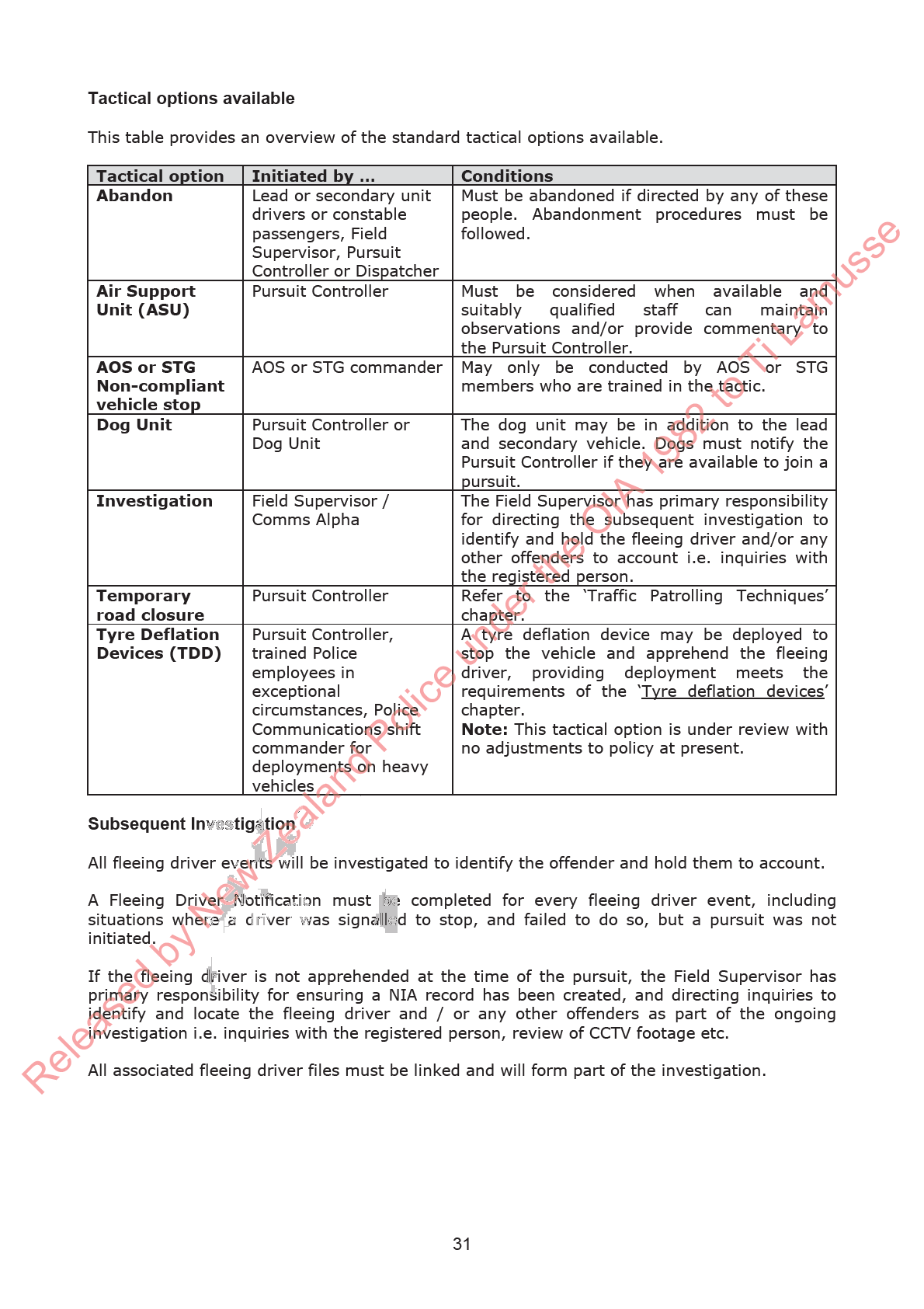
Air Support Unit
The primary role of the Air Support Unit (ASR) is to maintain observations and provide the
Pursuit Controller with enhanced situational awareness to inform their TENR risk assessment,
decision making and safe management of the fleeing driver event.
The Pursuit Controller retains control and command of the fleeing driver event at all times.
The Pursuit Controller may request ASU to;
• Take over primary responsibility for providing commentary
• Assist in the coordination of ground units to resolve the fleeing driver event safely
ASU will take all reasonable and practicable steps to maintain a covert presence. If aircrew
believe their aircraft has been identified by a fleeing driver, they must inform the Pursuit
Controller.
ASU will record and transmit all fleeing driver events through the use of video recording
equipment and operation of the downlink. If the transmission is not being received by the
Pursuit Controller, ASU must be advised.
1982 to Ti Lamusse
ASU are responsible for advising Police Communications of any relevant risk factors, including
any observed behaviour by Police which is inconsistent with this policy.
The direction to abandon a pursuit also applies to the Air Support Unit.
When the direction to abandon a pursuit is given by any person, ASU will immediately cease all
radio transmissions and await further direction from the Pursuit Controller.
This may include;
• Maintain observations with no commentary
• Maintain observations with limited commentary, with the intention of coordinating
affirmative action to stop the vehicle and/or apprehend the offenders
• Maintain observations with full commentary
• Vacate the airspace
Police under the OIA
If the direction is to vacate the airspace, ASU will leave the area as quickly and as safely as
possible, in compliance with Civil Aviation Authority rules and regulations.
If a vehicle is being tracked by ASU but has not been signaled to stop, this policy must still be
followed.
See also: ‘Police air operations’.
AOS/STG non-compliant fleeing driver stop
by New Zealand
In situations which are justified by a TENR assessment (e.g. armed driver or extreme risk to
public), AOS or STG commanders may authorise a non-compliant vehicle stop. This can only
be done where there is no other timely, practical method of containing the fleeing driver or
neutralising the threat they present.
AOS or STG personnel can undertake the tactic when:
• they are trained in its use; and
Released
• it is undertaken in accordance with AOS or STG Standard Operating Procedures; and
• authorised by an AOS or STG commander.
Given the importance of all units having a clear understanding of the tactical plan, if a non-
compliant vehicle stop is going to be carried out, it is preferable for this to be broadcast on an area
channel, rather than a tactical channel.
32
Appendix A – Fleeing Driver TENR Decision Making Tool
To assist our people make sound decisions in relation to fleeing driver events, a Fleeing Driver
TENR decision making tool has been developed. This is currently being trialled in recruit driver
training and PPDP training. Once finalised and approved, this wil be added as Appendix A.
1982 to Ti Lamusse
Police under the OIA
by New Zealand
Released
33
Appendix B – Summary of TENR to Verbalise to Comms
The examples below have been provided below to assist our people understand what is expected
in relation to communication around TENR. These may require some adjustment to align with the
Fleeing Driver TENR decision making tool (Appendix A) once this is finalised.
1.
Urban location - 0200hrs
Threat:
Following a [vehicle description]. Smashed rear window. Manner of driving
currently good.
Exposure:
Looks three up. No other traffic. Heading [direction] on [road].
Necessity:
Suspected stolen vehicle (low)
Response:
Likely to flee. DCC / Comms / TOC / Eagle – can you get this on camera?
Comms – can we get some extra units to our location?
Vehicle theft is defined as a serious offence. Targeting and catching offenders contributes to
Our Mission of being the safest country. However, a property crime is unlikely to justify the
risk of harm created by engaging in a pursuit.
1982 to Ti Lamusse
2.
1U complaint
Threat & Exposure:
We’ve located the vehicle – it s deliberately being driven into the path
of oncoming vehicles.
Necessity:
If we don’t act immediately, someone’s going to be kil ed (critical)
Response:
My plan is to [communicate plan and tactics here] or Comms, can
you assist with a plan
Driver poses a certain and ongoing threat to other road users. Police must act to mitigate the
risk of harm.
Police under the OIA
3.
Fails to remain stopped - Wanted to interview
Threat:
Male wanted to interview (breach of PSO) has driven off from our 3T.
Exposure:
Moderate traffic.
Necessity:
Not in pursuit (minor)
Response:
Person is [name]. We’l call the protected person to check on their safety.
Known offender, posing no immediate threat. Safety of the protected person is the primary
consideration. Event can be resolved through an investigation.
by New Zealand
Released
34
Appendix C – Key roles and definitions
This table outlines the key roles and definitions used in this policy.
Term
Definition
Abandon
Permanently abandon the fleeing driver pursuit.
Air
Support The primary role of the Air Support Unit (ASR) is to maintain
Unit (ASU)
observations and provide the Pursuit Controller with enhanced situational
awareness to inform their TENR risk assessment, decision making and
safe management of the fleeing driver event.
ASU has no command or control role in fleeing driver events.
The Pursuit Controller may request ASU to;
• Take over primary responsibility for providing commentary
• Assist in the coordination of ground units to resolve the fleeing
driver event safely
Dispatcher
Manages the radio channel, notifies the Pursuit Controller of the pursuit.
May abandon the pursuit prior to the Pursuit Controller taking command
1982 to Ti Lamusse
of the event if no TENR assessment has been supplied by the pursuing
unit.
District
Have no Command role in fleeing driver events
Command
Centre (DCC)
and NCCC
District
Nominated by the District Commander to review fleeing driver events in
Reviewer
their district.
Field
The field supervisor overseeing the incident. This may be different to the
Supervisor
pursuing officer’s line supervisor.
Fleeing driver
A driver who has been signaled to stop by a constable but fails to stop or
remain stopped.
Investigation
Subsequent inquiries carried out to identify and hold the fleeing driver
and/or any other offenders to account.
Lead vehicle
The first Police vehicle pursuing the fleeing driver.
Police under the OIA
Lead vehicle
The driver of the lead Police vehicle pursuing the fleeing driver. This will
driver
usually be the driver of the Police vehicle that initiated the fleeing driver
event, or the driver of the vehicle that has replaced the initial pursuit
vehicle at the direction of the Pursuit Controller.
Police
A constable who is a passenger in the lead or secondary vehicle.
constabulary
passenger
Pursuit
The Police Communications shift commander who manages the fleeing
Controller
driver event. If a Police Communications shift commander is
unavailable, a constabulary team leader may undertake the role of
Pursuit Controller. In exceptional circumstances, this may be a Police
by New Zealand
employee who is not a constable.
Secondary
The second Police vehicle in a fleeing driver pursuit that follows the lead
vehicle
vehicle.
Signaling a
Driver is signaled to stop by a constable using flashing red and blue
driver to stop
lights and/or a siren. An officer in full uniform may also signal a driver to
stop.
Released
Tactical units/s Any Police officer not actively pursuing the fleeing driver but available to
carry out tactical options as directed by the Pursuit Controller.
TENR
TENR (Threat, Exposure, Necessity, Response) is a risk assessment and
decision making process that supports the timely and accurate
assessment of information directly relevant to the safety of Police and
others.
35
Urgent duty
Urgent duty driving is when an enforcement officer on duty is driving
driving
above the speed limit or the natural flow of traffic, and may not be
complying with certain traffic rules and is either:
• responding to a critical incident
• gathering evidence of an alleged offence
• apprehending an offender for an alleged traffic or criminal offence
• responding to a fleeing driver event in accordance with the Fleeing
driver policy
• providing security to, and facilitating the movement of, an official
motorcade as part of an operation (as established in the relevant
Operation Orders)
• engaged in activities approved by the Commissioner in writing
and are relying on the defences under the Land Transport (Road User)
Rule 2004 (RUR) and the Land Transport Act 1998 (LTA) for not
complying with certain traffic rules and regulations which would prevent
the execution of that duty.
1982 to Ti Lamusse
Police under the OIA
by New Zealand
Released
36
















